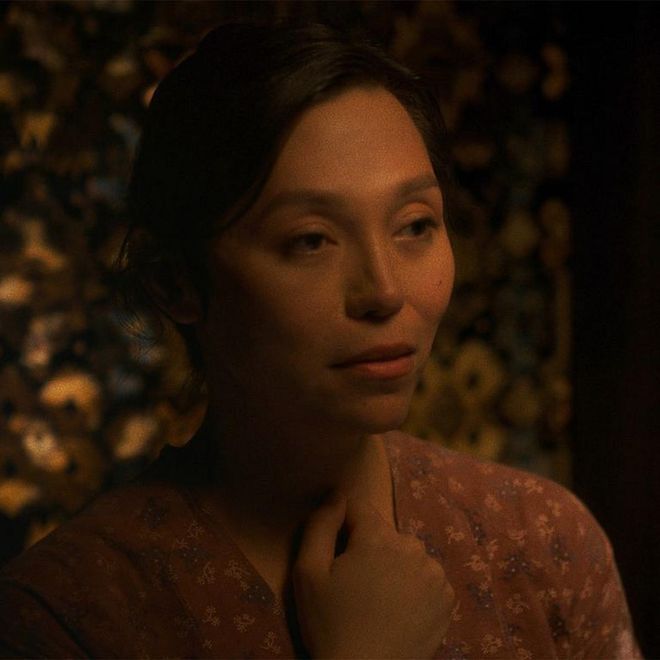Director Isabel Sandoval Wants to Shed Light On Invisible Women
After making history as the first trans woman to compete at the Venice Film Festival, Sandoval returns with a short film, Shangri-la, for Miu Miu.


Isabel Sandoval (Photo: Brigitte Lacombe)
After wowing with her 2019 feature film, Lingua Franca, director Isabel Sandoval returned yesterday with the short film Shangri-La, created for Miu Miu’s Women’s Tales film series.
The Philippines-born, New York-based filmmaker follows Agnès Varda, Ava DuVernay, Miranda July, Mati Diop, and many more women directors in the brand’s annual program. Given carte blanche for the story and a look book of Miu Miu clothes for the wardrobe, Sandoval wrote, directed, edited, and stars in a 10-and-a-half-minute piece that explores imagination, forbidden romance, and racial prejudice.
Related article: Miu Miu’s Upcycled Vintage Dress Capsule Has Us Ready For 2021
Set in the United States during the Great Depression, Shangri-la follows a Filipina farm worker in a secret love affair with a white farmhand in a time when interracial marriages were outlawed. (From 1850 to 1948, California’s miscegenation statute prohibited different racial groups from marrying each other, the film states in its opening scene.) The piece begins with the protagonist in a confessional, admitting her feelings for her lover and invoking the fantastical worlds she creates in her mind where they can be together freely.
“As a filmmaker, I tend to be drawn to women protagonists who are either forgotten or not heard much about, especially in very pivotal moments in history,” Sandoval tells BAZAAR.com over Zoom. Her second feature film, Aparisyon, follows Philippine nuns leading up to Ferdinand Marcos’s declaration of martial law, while Lingua Franca centers on a Filipina trans caregiver living undocumented in Brooklyn during the Trump era. But in Shangri-la, she tells a different kind of story. Set during the Great Depression, it’s not economic or political; rather, it’s a film about a marginalized woman “coming into her own power.”
Related article: The Gossip Girl Reboot Will Be “Reflective Of The Times” We’re In
“When we think about the Great Depression, it’s always white Americans suffering,” Sandoval explains. “And not to take anything away from the suffering and the hardships that they experienced, but America is a nation of immigrants and it’s made up of people who have come here from different countries in Europe and Asia. But a lot of Americans in the present day seem to think that all these people just arrived in the last 10, 15 years. I wanted to take this opportunity with Shangri-la to shine a light on this invisible woman.”
With Lingua Franca, Sandoval made history as the first trans woman of color to compete at the Venice Film Festival. Acquired by DuVernay’s ARRAY and later released on Netflix, the film has since earned global awards recognition, including a Best Actress win at the International Cinephile Society Awards and a nomination for the upcoming Film Independent Spirit Awards. “I’m on cloud nine, but I also want to use this energy and this excitement about my work and my career to continue taking risks in my work,” she says of the praise.
Related article: Tracee Ellis Ross: “We Tell Universal Stories Through The Lens Of A Black Family”
Having grown up an only child, Sandoval has been focused and productive in the isolation of the pandemic. “I’m in my element when I’m by myself.” She made Shangri-la in two months after being approached by Miu Miu in November, shooting under strict health guidelines in a Los Angeles soundstage. She finished writing her next film, successfully pitched a TV series, and just started a new screenplay while attending the artist residency Yaddo in upstate New York, whose alumni include James Baldwin, Truman Capote, and Hannah Arendt.
Here, Sandoval talks to BAZAAR about Shangri-la and what’s ahead.
In Shangri-la, you conveyed the protagonist's reveries through clothing, and it's helpful that you had Miu Miu on your side. Did you have an idea of what the outfits would look like specifically?
I had a look book as a reference while I was writing the script, but for the longest time, I've always had an ambivalent relationship to fashion. I'm not like, your fashionista. To be very honest, sometimes I feel fashion can be frivolous. I grew up in a developing country, and I was surrounded by people who had to worry about having food at a table and a roof over their heads. I wanted to use fashion in the short film, not to glamorize it, but [to use it] as a commentary. And, of course, since this woman is a hard scrabble, blue-collar farm worker, I wanted to shake up and mix up the context in which I show the fashion. And that these Miu Miu outfits that she wore kind of represented the possibilities and the future for her. But they still existed within the realm of kind of like a dreamscape or her stream of consciousness, because I wanted the clothes to just be an external manifestation of her inner radiance and her vibrancy.
And that's why, at the end of the film, we're brought back to the church confessional and to that overhead shot of this woman sleeping at a clearing and that she's back to her less-than-ideal reality. But she's armed and she's wiser and she's come to a deeper realization of her own worth and dignity and value as a person. And that's what I thought was important.
Related article: Michael B. Jordan Is Developing A Muhammad Ali Series For Amazon
You mentioned in your intro that even though your stories aren't biographical, they are personal. And the woman's journey of coming into her power was a reflection of your own experience. Would you be open to sharing a little bit more about what that journey was like for you?
I feel like as a minority filmmaker, when you're applying to grants and funds, they only fund your project if it fits certain requirements and expectations about the kind of story. So Lingua Franca, even though my execution was uncompromised, it was completely my vision. I had in mind a kind of project that I wanted to get funded. It was easier to fund something that talked about how difficult and challenging it is to be an undocumented trans woman in the U.S., but these kinds of movies tend to be quite didactic or preachy. And that's where I wanted to deviate from what was expected of me as a storyteller. So instead of coming up with a film that might be preachy or loud or predictable, I made Lingua Franca, something delicate, lyrical, sensual.
And I got quite a bit of pushback at different places of making the film. In development, for instance, I submitted to a renowned filmmaker lab that turned down the project, again, because it's a more sensual take on the trans immigrant story. And when I was shooting the film, understandably, I also had pushback from certain people, certain producers, because I had the audacity to write, direct, edit, and then act in my own film. And when we were editing the film, we had an investor in the Philippines who hated the ending. Who wanted something more happy or melodramatic, easy to understand, and sellable. And I pushed back on all of those things. So it was really quite a vindicating feeling for me when we got that phone call from the Venice Film Festival in early August saying that they would love to have our film premiere.
And since then, seeing the trajectory that Lingua Franca has been on and how it's been warmly received, which is still, to be honest, quite surprising to me, because I feel like the sensibility of Lingua Franca is quite rare and quite art house and idiosyncratic that I'm surprised that another person would understand the film considering how personal it is. But now, when Miu Miu reached out to me for Shangri-la, I just felt like I was in a better place as a filmmaker. I have the industry kind of believing, already convinced or starting to be convinced, and persuaded of my talent and my vision. And so I wanted to really do something that excited me and that I hadn't done yet before as a Filipino filmmaker. In the history of Philippine cinema, almost all our acclaimed films in the international scene have been heavily social realist or neorealist in orientation. And I hate using the term, but some of them have been accused of poverty porn or glorifying and romanticizing—
Trauma.
Exactly. And for me, another thing that I realized was that cinema is all about seduction. It's about evoking rich, intense, passionate feelings, and that's the kind of emotional experience that I would want my audiences to have when they see my films. And I started that a little bit with Lingua Franca, but now I feel like I'm pushing that even further, which I love because I did not go to film school.
When I think of stories, they're almost always feature length. I don't come up with short-story narratives. That's because growing up, I did not watch short films. I watched 90-minute, two-hour movies. So I thought this Miu Miu opportunity was a chance for me to also play with the form and structure of short film. There's almost always conflict or tension, and then release. I'm sure there are people that were like, "What happened to the boyfriend at the end?" [Laughs.] "Did she finish her confession?" And you know what? At the end of the day people are not going to necessarily remember your story, the plot, or the quirks of the characters, but they will remember how your film made them feel. That was my guide in making Shangri-la.
Your films don't just use Filipino culture as a backdrop. It's fully immersed, it's basically a character itself. What's the importance of conveying the culture in your own way, for you and your storytelling?
It happens quite organically and naturally. It's not something like, "I want Philippine culture to be front and center."
It's just the kind of characters that I come up with and the kind of stories that I come up with. And it's interesting, because I left the Philippines 15 years ago and in certain respects, and I'm sad to say this, it no longer feels like my home. Because about 10 years ago, they passed this law prohibiting trans people from changing their name and gender marker. The law did not exist, but they went out of their way to become bigots. But I guess with the stories that I still come up with, it's almost always anchored and rooted in Philippine culture and history. And even the new one, Tropical Gothic, is that way. You can take out the Filipino or the Filipina from the Philippines, but you can never take my country away from me.

Sandoval in Shangri-la. (Photo: Courtesy)
You tweeted recently how you use romance to interrogate larger social issues, which you do in Lingua Franca and in Shangri-la. What is it about romance that draws you in?
You know, for as long as I can remember, I've been so jaded and cynical. [Laughs.] Because I'm quite a snobbish cinephile—my film school was really exposing myself to all kinds of world cinema, auteurs like Kurosawa, Almodóvar, Wong Kar-wai—and I have a soft spot for European art house, like Ingmar Bergman, Michael Haneke, almost always grim, serious.
For some reason, the stories that I come up with tend to have a romantic angle. Jean Cocteau, the French filmmaker, once said that directors make the same movie over and over again, over the course of their careers, and the settings just change, the characters just change. For me, my thematic obsession and fixation has been women with secrets who are forced to confront very personal choices in fraught sociopolitical settings. And almost always, there's a romantic angle that's also very fraught, because they might belong to different economic or social classes.
In Lingua Franca, that's quite obvious, because she's undocumented, he's a citizen and Caucasian, and that's also the same dynamic in Shangri-la. The relationships are interracial, because it's us being considered persons of color in opposition to being white or being Caucasian. That, to me, feels like such a rich and complex context to examine the social issues, because we exist in a culture that's dominated and dictated in certain ways by white and cisgender people.
I wanted to jump into your next film too. You just finished the screenplay, and it sounds so fascinating. It's kind of a colonizing-the-colonizer story. Where did the interest in 1570s Spanish colonization in the Philippines come from?
First, I wanted to do something that wasn't going to be pegged as social realist and more as a historical or period drama. I just feel like because it belongs to that kind of genre, the standards, expectations are different. But I also just used that as a jump-off point to really experiment and play with mood and atmosphere and tone. I don't want to make a stodgy or antiquated costume drama, I wanted it to feel raw and visceral.
I think my biggest aesthetic challenge and risk that I want to take with Tropical Gothic is how it can use elements of atmospheric horror to conjure and evoke the feeling of romantic ecstasy and rapture as if it were a religious experience. Because for the longest time in cinema, love and romance is almost always portrayed like lollipops and roses, just warm and fuzzy. But for some people, especially for those people that feel so intensely and so passionately, it's in a way like being spiritually possessed. … I'm going to be taking the mood of spellbinding darkness in Shangri-la to an extreme in Tropical Gothic.
Do you have a general timeline of when you see this coming out? What kind of production details can you share?
I'm not acting in it—for now. It could change. But I'm very, very excited that CAA, which is repping me as my agent as writer and director, is helping package and put the financing together for that project. We hope to shoot in the fall in the Philippines. And I would want it premiering at one of the major international festivals next year, hopefully. It will be probably too soon for Berlin, but I'm hoping either Cannes or Venice will be where we can premiere Tropical Gothic.
This interview has been edited and condensed for clarity.
This story first appeared on Harper’s BAZAAR US